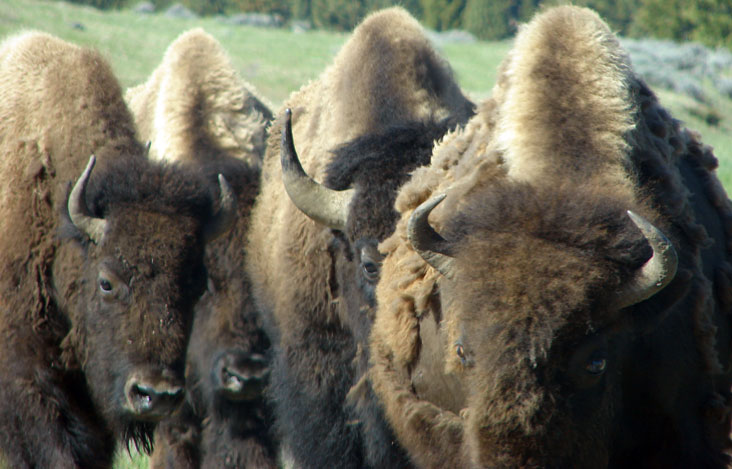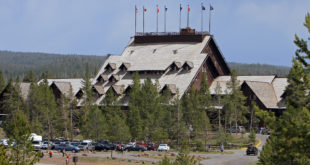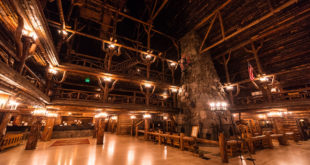Yellowstone’s not out to get you; but it can.

The park service has been sued many times about whether it does enough to protect visitors. Over the years a kind of legal framework has been built that, roughly speaking, entrusts the park service with the job of informing the public about the dangers of Yellowstone, of erecting sufficient barriers or safeguards where the public is most at risk, and of enforcement of park safety regulations. However, it is also recognized that Yellowstone National Park is, for the most part, a wilderness and a volcanically active land. As such, there is always risk, however slight; it’s part of the ‘danger’ and the ‘thrill’ of seeing wild animals or walking volcanic terrain. The park service cannot and should not attempt to protect visitors from every possible danger. People visiting the park should have some knowledge of potential risks, but they must also exercise their own judgment.
That’s why you see fences, rails, boardwalks, signs, and park literature all designed to inform and keep people safe – but the ultimate responsibility lies with the individual, or the guardians of children.
The difficulty with this, as it is in any wild or rugged area, is that the exercise of judgment or even common sense in an unfamiliar environment may be faulty. While most people instinctively feel it’s better to leave bison alone, some people believe it’s not risky to approach them. Every year people are gored by bison because they think they’re just another version of a cow. Or with more subtle ignorance, are unaware that wild bison are far more sensitive to human presence than cattle, can run 35 miles per hour, can turn on a coin – and both males and females have horns.
Many Hazards – Just Like the Big City, Only Different
The list of potentially hazardous things in Yellowstone is quite long, for example: bears, moose, bison, wolves, thermal pools, geysers, snowstorms, numbing-cold water, sulfur dioxide fumes, earthquakes, and above all automobile traffic. Yet every year about three million people visit the park, and only a few dozen sustain any kind of serious injury, most of those in vehicle accidents.
Hiking or camping along park trails, especially away from the big concentrations of visitors, might seem more dangerous but it’s not. It’s true that the possibility of encountering a bear is slightly higher, but a few precautions (such as, don’t hike at night, make noise on blind corners, avoid any visible bears, follow the regulations on clean-camping) minimize the hazard.
It pays to consult park literature (given to everyone when entering the park) on the do’s and don’ts for safety in Yellowstone, especially for first-time visitors. The warnings and cautions need to be taken seriously, but not as dire. As old timers endlessly like to point out: It’s a lot more dangerous to drive crowded freeways or stroll through parts of some big cities. A little educated common sense provides a large margin of safety in Yellowstone.
Yes, Fatality is Present
Since the questions are often asked: People have died by falling into thermal pools, some have fallen or driven into the Grand Canyon of the Yellowstone, many have been mauled or gored to death by animals, many more have drowned in Yellowstone Lake. Some of the victims have been children. The subject is both tragic and lurid, enough to provoke a book by the park historian, Lee H. Whittlesey, Death in Yellowstone: Accidents and Foolhardiness in the First National Park.
Driving Mountain Highways Safely
Every year millions of people travel over mountain roads in the Greater Yellowstone Region and come home safe and sound. There’s nothing special about mountain highways that you won’t encounter elsewhere, except perhaps 1,000 foot drop-offs, hairpin curves, and 6-9 percent grades that go on for twenty miles. What are a few white knuckles for all those views and vistas?
Actually, driving anywhere in Yellowstone Park is essentially mountain driving, and so is most of the Greater Yellowstone Region. There’s nothing to it if you use common sense, which in most cases simply means driving at appropriate speeds for the conditions. Posted speed limits and recommended speeds are serious on mountain roads. One other thing, make sure your brakes are in good working order. For some vehicles, downshifting is better than braking.
As a rule of thumb, the more curves and steeper grades in a mountain highway, the better the scenery.
For those who like mountain driving (and this does not necessarily mean you’re into Formula 1 racing), the highways through the Bighorn Mountains (U.S. Highways 14 and 16) are very scenic and curvy. However, they do not begin to compete with the Beartooth Highway and its 63 switchbacks, u-curves, and s-curves or its nearly 11,000 ft elevation.
Hazards
There are a few hazards in mountain driving, which while hardly unique to the mountains, tend to have a more dramatic setting. Here in rough order of importance are some hazards to watch for:
- Animals in the road. Animals in the road are quite common, especially during the twilight periods of morning and evening. Some areas of the Greater Yellowstone Region are open range, meaning that cattle are allowed to graze freely and often use highways for travel paths. Deer, antelope, moose, elk, and bison all cross highways and are more than big enough to damage or destroy a vehicle. Animals are a major reason why people should think twice about high speeds in the mountains and that goes double at night.
- Rocks on the road. For highways passing steep slopes, rocks and other debris in the road are most common in spring and fall or during a prolonged wet spell. Rocks in the road can range in size from pebbles to boulders the size of a house. Probably the worst for drivers are the small to medium-sized rocks (3-6 inches in diameter), which can be quite difficult to see and are big enough to damage tires.
- Vehicles over the center line. This happens often enough to keep any driver alert when rounding a blind curve (and a lot of mountain curves are blind). There are some legitimate reasons for crossing the center line, such as avoiding an animal or rock, but it’s always a risk. Some drivers make a habit of riding the line and cutting curves, for a while at least.
- Wet or icy roads. Slippery is dangerous on any road, but in the mountains the danger is often dramatic. Even so, the biggest danger is underestimating the risk, especially if you’re not familiar with driving steep and curvy roads in bad weather. Sometimes discretion is the better part of valor; if it feels too dangerous to drive, believe your intuition and go back.
- Snails. On mountain highways vehicles moving 20 mph (and less) with a caravan of 3 to 30 cars behind them are a menace. People do crazy things to get around them. Unfortunately snail behavior is not always voluntary; sometimes crawling (especially uphill) is all the vehicle can manage. Fear can also motivate snail speed, and with some mountain roads being what they are – who’s to blame the cautious? The point is: slow speed may be unavoidable, but not pulling over periodically to let others go by is unexcusable (see Road Hog below). If you need to drive slowly (and this isn’t necessarily a pejorative), use the pullouts – you’re not in a hurry anyway, right?
- Road Hogs and Other Crazy Driving. Everyone has encountered bad/crazy drivers – speeders, weavers, tail-gaters, road hogs. They can be found on mountain roads too. Mountain roads magnify the danger. Maybe it’s best to look at it this way: mountain scenery is beautiful.If you encounter crazy driving, pull off at the nearest convenient spot and let them get on with their madness.
 Yellowstone Insider Your Complete Guide to America's First National Park
Yellowstone Insider Your Complete Guide to America's First National Park






